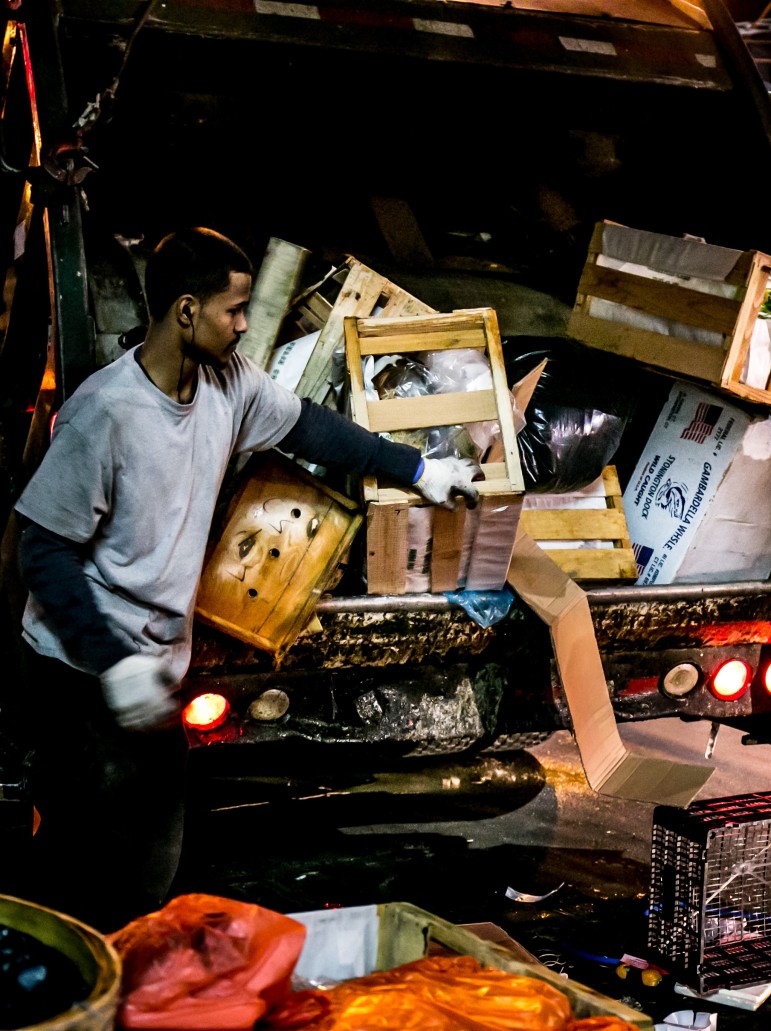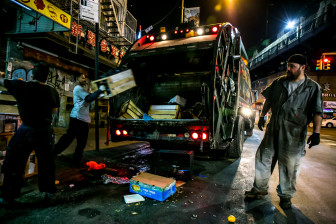
Adi Talwar
Commercial waste haulers at work late one night in May 2015.
Which of these statements are true?
1. A Waste Worker Dies Every Day
2. 43 New Yorkers have been killed by waste collection trucks since 2010
3. Safety is both a national and local priority for the waste services industry.
Only the last.
While all three are about the commercial waste and recycling services sector that provides essential but thankless service every day to keep New York City clean and manageable, they show how even basic data is misrepresented – often for political purposes.
The first was a misguided headline in a recent New York Times op-ed, corrected and replaced within twelve hours of initial publication. The author admitted to conflating data from multiple industries to make an unduly provocative pronouncement, which the Times didn’t catch.
The second – found in a recent opinion – is off by more than 50 percent. While still an unacceptable number, recent analysis of data supplied by the Business Integrity Commission and the Department of Transportation finds 20 deaths related to crashes involving a commercial waste truck over the eight-year period from 2010-2017.
The primary reason for the differences: flawed data that conflates various types of heavy trucks along with the subset dedicated to collection of commercial waste.
These numbers are important for several reasons.
First, the politics: in case you haven’t noticed, the city has started an important debate about whether to restructure how commercial waste is handled. New York is considering adopting a system of geographic zones served by exclusive franchise-winning companies. Such a dramatic shift requires coming up with a good reason, and in this case, anecdotes about safety fit the bill.
Second, it’s too easy to believe the worst about the waste services industry, to blame it for not recycling the wastes we all generate and throw away, and to look past the real people that provide this essential service. Even the multi-generational companies that comprise most of the local industry must constantly strive to overcome the dark legacy of generations past.
Third, smart managers know you need good data to manage a problem; the same is true for passing laws and regulations to address it. But in the same ways that crash data is flawed, good data about truck inspections and worker hours also is elusive.
Unfortunately, the politics pushing this debate would prefer a “magic bullet” answer – like shifting from an effective open-market system to an untested idea of geographic zones.
It’s good to be skeptical of that proposed solution: the rhetoric that zones equal more safety is not supported by evidence, and has other consequences. In Los Angeles, the recent shift to zones severely disrupted waste-related services and locked in rates that doubled, tripled and quadrupled. The push to zones also conveniently overlooks how safety is a “continuous improvement” project that is never over in any industry, but can be part of a well-regulated system – like NYC already has.
Plus, carpe diem! Waiting five years for a zone/franchise system ignores what can be accomplished now – and next year – by working collaboratively, with full support from both industry and labor.
The waste industry and its unions know that the very nature of its operations are dangerous – to workers and the public alike – for a host of understandable reasons. But pointing fingers to blame others distracts from the job at hand.
That’s why both national industry and labor are committed to solution-oriented initiatives that embrace all aspects of safety – further establishing a “safety culture,” effective use of innovative technologies; and continuous training of all types for all workers.
Locally, in April the industry will hold our fourth semi-annual safety symposium, co-produced with assistance from the BIC. More than one hundred managers from industry and labor will attend, this time with a special focus on technologies of all types.
Companies participating in the past three events affirmed these efforts have led to positive improvements in company operations, and best practices.
Moreover, today’s trucks that collect recyclables, organics and waste mirror the safety features in personal vehicles: on-board cameras surrounding the truck, remote monitoring of driving behavior, sophisticated routing and data-management systems, and accident-avoidance alerts.
Already a well-regulated industry, most trucks already have injury-preventing side-guards – many emblazoned with VisionZero messages – well before the 2024 target. Clean-emission engines are required of all waste trucks by 2020; one major company already has 75% of its nearly one hundred trucks compliant.
Clearly, working together on safety is moving us forward; an 18-month collaboration with the city, labor and industry produced a Trade Waste Safety Manual documenting best practices, to be supplemented by a set of training videos. BIC convened the workshops, but significant contributions from those in the field was required to create new and higher standards.
While each fatal crash has its own unfortunate story, and Vision Zero initiatives are making both structural and behavioral improvements in safe streets for all, New Yorkers also can help by being more alert as pedestrians, cyclists and drivers. Our drivers and helpers also want to return home safely to their families at the end of their work-day.
The real way to make our streets safer starts with good data, and good faith intentions. Let’s give that an honest try.
Fritz Schneider is business manager of Laborer Local 108. Jose Maldonado is principle of Maldonado Associates LLC and senior advisor to New Yorkers for Responsible Waste Management, and he previously served as commissioner of the city’s Business Integrity Commission.
 New York’s Trash Challenge
New York’s Trash Challenge
May 2015
The more than 10,000 tons of garbage that New York City produces a day are taking a rising toll—in higher municipal spending, the city’s carbon footprint, burdens on neighborhoods and impact on landfill communities from upstate to Kentucky. Can New York come up with a better way to take out the trash?









2 thoughts on “CityViews: Debate About NYC’s Commercial Waste Needs to Focus on Sound Data”
I think the waste industry was better when the mob ran it. At least they knew what they were doing.
Pingback: How the Trash Industry Worked Overtime Trying to Thwart New York City’s Reform Plans – Philanthropy Media Network